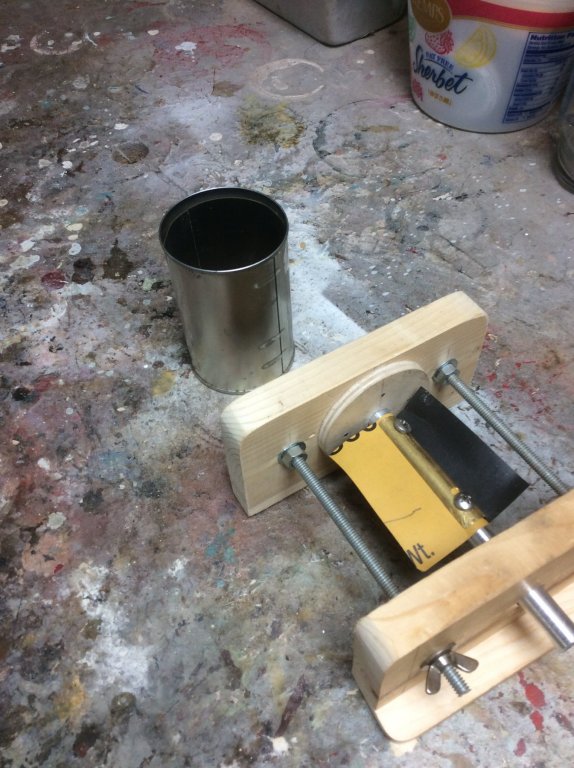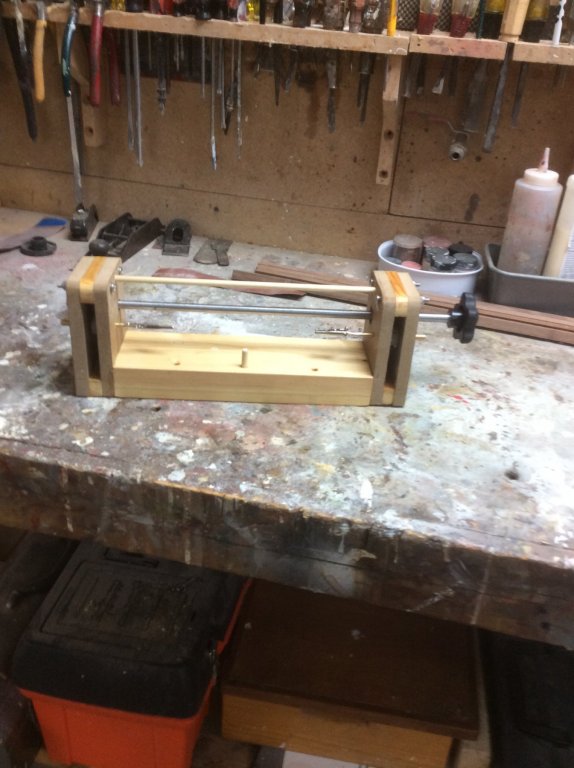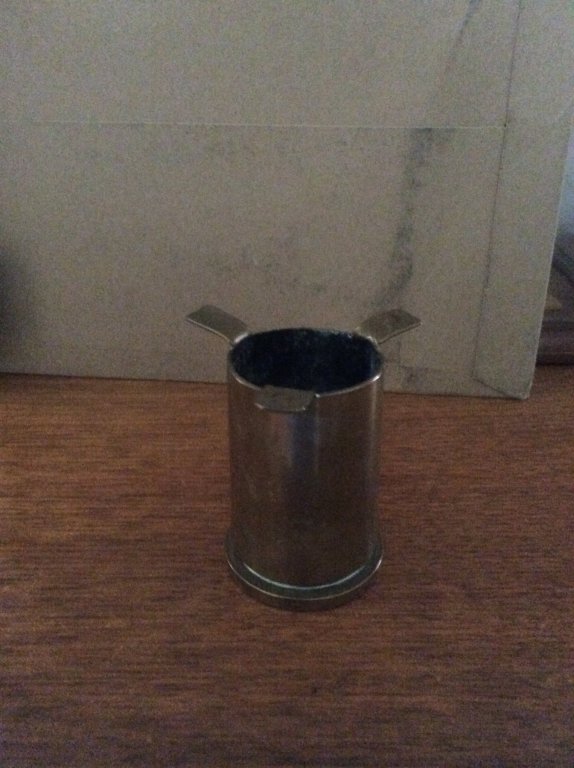
Roger Pellett
-
Posts
4,519 -
Joined
-
Last visited
Content Type
Profiles
Forums
Gallery
Events
Posts posted by Roger Pellett
-
-
When I was 7 years old my mother took me to see a collection of ship models on display at O’Neils Department Store in nearby Akron, Ohio. It was a life changing event and from that moment I was fascinated by ships in general and ship models in particular.
68 years later I still remember some of those models and have visited them several times at the Mariners Museum in Newport News, VA. The models that I saw were the magnificent ones built by August Crabtree. It’s too bad that this inspiration is not available to more kids today.
Roger
-
Dick,
If I understand your plan correctly, the word “cunning” does not do it justice. You are in fact replicating in miniature a process that could have been used 700 or so years ago to build the real thing. Although the original builders would not have had a jig like you show assembling frames from segments calculated from your half lune is a plasuable scenario.
Too few people today realize that even after the invention of the practice of lofting from a formal lines drawing c 1600’s most ships were built using some sort of rule of thumb system much of which has been lost to history.
Roger
-
I just dug out my copy of the book, and table 9.1 is printed correctly. Send me a P M and I will mail you a copy. My ability to produce this electronically is limited.
Roger
- rtwpsom2, thibaultron and mtaylor
-
 3
3
-
-
Today I finished my block polishing machine, crude but it works. Made entirely of on hand scrap so it cost nothing. It is powered by my Sherline lathe on a slow setting. The tin can is lined with 800 grit wet dry and the flappers are made from the same. I may experiment with more aggressive paper down the road.
Roger
- lmagna, Seventynet, RichardG and 4 others
-
 7
7
-
The term “fast” with regard to sailing ships is complicated and depended on the situation. In light air it could relate to a vessel’s ability to ghost along. In this case, a light small vessel with minimal wetted surface area could have an advantage over a large heavy frigate. In heavy air the frigate with its much longer waterline length and greater stiffness allowing it to carry sail would give it an advantage.
Point of sail was also important. Small sloops and schooners could often sail closer to the wind than square riggers, so they were hard to catch if upwind of their larger prey. On the other hand a small sloop chased off the wind in heavy air by a frigate would be in a dangerous situation.
Roger
- mtaylor, popeye the sailor, Piet and 1 other
-
 4
4
-
The reason for staggering joints in planking was of course to avoid a weak spot in the hull girder. In this case the guards are not longitudinally continuous so do not contribute to the longitudinal hull strength. Furthermore, the major longitudinal strength member for these river craft were the hogging chains. I therefore see no reason why joints in the guard planking need to be staggered. The hull itself is of course a different matter.
Roger
-
In “Vasa, A Swedish Warship”, Fred Hocker discusses the colors found on Vasa, and they are much brighter than obe would expect. He also points out that Vasa is an exception, a warship specifically designed and built to emphasize the prestige and status of the Royal house of Vasa. These bright colors, many using pigments of ground semi precious metals would not be found on more humble ships.
i believe that the best work on colors for US vessels built in the 1800’s is Eric Ronnberg’s article published in the Nautical Research Journal. Abridged versions are to be found in the NRG’s shop notes and on their website.
-
Michael,
Great to see that you are now again working on this wonderful model. Another Michael (MikeB4) recently included a post about a model of the US flagged passenger ship African Enterprise c1950 that he found in a flea market. He said that it is kind of rough and you immediately came to mind as the guy who could return it to its former glory.
Roger
-
The fictitious tackle above is an example of relying too heavily on old models as primary evidence for constructing historically accurate models. This is especially true of rigging which being fragile is often repaired or completely replaced. The book from which the drawing was taken documents the models of three vessels in the Statens Sjohistoriska Museet in Sweden. The author makes no attempt to note anachronisms or physically impossible arrangements limiting the book’s usefulness.
Roger
-
Very nice! Unlike many small boats built from kits, this actually looks like a ship’s boat of the period. Nice workmanship too.
Roger
- Jim Rogers, mtaylor, greenstone and 1 other
-
 4
4
-
Perhaps not 4in x 4in but Steele says that floor timbers for a 32ft longboat are sided 3in, moulded 5-1/4 in at the throat and 3in at the head. Futtocks were sided 3in, moulded 3in at the heel x 2-3/4in at the head. These were heavily built boats intended for hard use.
Roger
- thibaultron, Canute, mtaylor and 1 other
-
 4
4
-
Since you have an owners manual, presumably you have scale drawings. Xerox to the correct scale, get a block of close grained hard wood and srart cutting away everything that does not look like a Hercules engine! Kidding aside, there is an NRJ article, I think 2001 written by a guy who built a 1:12 Buda Diesel engine for a US Navy 1940 admiral’s launch. He started with a block of casting resin. A straight six engine should not be difficult to carve.
Roger
-
-
Mast rake is also used to adjust the “balance” of a sailing vessel. If the vessel under sail tries to head up into the wind it is said to have a weather helm. The opposite, where the boat heads downwind is called a lee helm. Raking the masts changes the geometric center upon which the wind forces act thus correcting the lee or weather helm.
There are accounts during the age of sail where Captains changed mast rake or even mast position to improve their ship’s performance.
Roget
-
Today I finished my serving machine. The only specially purchased parts were the two alligator clips. Everything else came from the scrap box. I picked the gears up as samples at a trade show many years ago, but never found a use for them. Much to my surprise the thing actually works, Now I can get busy and rig my longboat.
Roger
-
Re: Stacked Boats
i don’t know what period the above Constitution model represents but by mid Nineteenth Century US practice was to nest the cutters in the 1st and 2nd launches. All of the thwarts in the launches were removable. When in use thwarts were fastened by iron pins into heavy clamps worked into the boat’s interior structure. This allowed the stack of boats to be considerably lowered.
See: William Brady, The Kedge Anchor.
Roger
- JerseyCity Frankie, Canute, mtaylor and 1 other
-
 4
4
-
I highly recommend the book Gondola, An Extraordinary Naval Architecture, by Carlo Donatelli (listed in Wefalk’s comprehensive bibliography above). This large, beautifully produced book covers gondola design and construction in detail. The book was originally published in Italian but my copy is an English translation.
The book mentions a set of gondola plans in the Museo Storico di Venezia that the author translated into a CAD file.
Roger
- druxey, thibaultron, mtaylor and 1 other
-
 4
4
-
Copper sheathing was attached to ships’ hulls with copper nails, not rivets. At a scale of 1:64 a 1/2in nail head would scale less than .01in diameter (less than .25mm) and the head would barely protrude from the surface of the plate. The embossed nail heads on the plates that you show above are way over scale. At this scale, I would question to show fastenings at all.
Roger
-
-
-
Iron oxide pigment was available in the 1700’s and still is used to produce a cheap construction primer. During my working career it was used as a temporary coating for industrial prefabricated piping that would be insulated after erection on site. It produces the typical “barn red” color. When the VOC regulations were implemented suppliers were able to produce it as a water based product. It cost about $14 a gallon gallon compared to $36 for more high tech products.
Roger
-
How did the model come into your possession.
Roger
- thibaultron, Omega1234 and mtaylor
-
 3
3
-





Finishing timber (boxwood)
in Wood discussion...Where to use it? Where to get it? What types are best? How to Finish it?
Posted
Jaager’s excellent advice does not mention a jointer but it can be quite useful when reducing rough stock. A warped, cupped or twisted board is hard to cut on a table saw or band saw without the blade binding and that is when accidents happen. With a jointer you can plane one surface. You then have a flat surface to lay on your band saw or table saw table for ripping stock. They are not easy to use but hollow ground table saw blades will produce smooth surfaces. Don’t try to use them if dull as they will burn the edges of your planking.
Roger